
International Journal of Linguistics Studies
ISSN: 2754-2599
DOI: 10.32996/ijls
Journal Homepage: www.al-kindipublisher.com/index.php/ijls
IJLS
AL-KINDI CENTER FOR RESEARCH
AND DEVELOPMENT
Copyright: © 2023 the Author(s). This article is an open access article distributed under the terms and conditions of the Creative Commons
Attribution (CC-BY) 4.0 license (https://creativecommons.org/licenses/by/4.0/). Published by Al-Kindi Centre for Research and Development,
London, United Kingdom.
Page | 115
| RESEARCH ARTICLE
Cebuano-Visayan Superbalita Select News Articles: A Morphosyntactic Analysis
Raiza Rhea Reponte-Sereño
College of Arts and Sciences, University of Cebu, Main Campus, Cebu Philippines
Corresponding Author: Raiza Rhea Reponte-Sereño, E-mail: [email protected]
| ABSTRACT
The present study conducted an analysis of the morphosyntactic structures found in three specific news articles from the
Cebuano-Visayan SuperBalita publication. The articles in question are titled "34 ka menor naluwas sa CCPO", "Signal Shutdown
Sa Pasigarbo Sa Sugbo", and "Manindahay Sa Carbon Nabalaka Sa Grabi'ng Alkansi". The study aimed to address the following
inquiries: the immediate constituents and rewrite rules of syntactic structures and the morphemic structures that comprise the
content words within sentences of the news articles. The research employed a qualitative approach, specifically utilizing structural
analysis. The frameworks of Corder's linear grammar and Pesirla's pedagogic grammar were employed, yielding the subsequent
discoveries: The analysis of the three chosen textual samples revealed the presence of sixteen simple sentences, eleven complex
sentences, and one compound sentence, specifically sentence 3, which was identified through its corresponding rewrite rules.
The second problem's data unveiled the morphemic structures of content words, exhibiting a total of fifty nouns, fifty-eight verbs,
five adjectives, and five adverbs. Most of the nouns present in the text are in their simple form, while three of them are compound
nouns, namely uplan bulabug, minur di idad, and tunga’ng gabi. The prefix "ka" is employed in the formation of five complex
nouns, namely kadagku-an, kagamhanan, kalihukan, kahigayuan, and kasumaran. On the other hand, the base words pama-agi
and pasigarbu are utilized in the formation of the remaining two complex nouns, using the prefixes "pama" and "pasi". Most verb
prefixes are observed to be bound morphemes, specifically "gi", "nag", "mag", "gipa", and "mu". The three chosen news articles
from Cebuano-Visayan Superbalita exhibit the manifestation of morphosyntactic linearity, as indicated by the findings. Therefore,
additional research on morphology and syntax may serve as a starting point for discourse that employs indigenous languages.
| KEYWORDS
Cebuano-Visayan, morphology, syntax, pedagogic grammar, linear grammar
| ARTICLE INFORMATION
ACCEPTED: 15 June 2023 PUBLISHED: 30 June 2023 DOI: 10.32996/ijls.2023.3.2.9
1. Introduction
Cebuano-Visayan constitutes the primary language of the country. It belongs to the Malayo-Polynesian branch of the Austronesian
language family. Cebuano-Visayan, which is also referred to as Sugbuanon, Bisayan, or Visayan, is utilized as a lingua franca in
Central and Southern Philippines, being spoken by approximately two-thirds of the Philippine population. The language is utilized
in Mindanao, Cebu, Bohol, and certain areas of Samar (Bernad,1972).
Cebuano-Visayan is a highly developed language with a vast vocabulary and complex grammar, and it has a substantial readership
across different areas, especially in mass media. Despite numerous speakers of this language, there have been many inaccuracies
in its syntactic system, word structure, and orthography visible in local-based written discourse. These inaccuracies correspond to
the insufficient grasp of the native speakers towards acquiring the Cebuano-Visayan as a first language.
With the gaps mentioned above, a native Cebuano-Visayan speaker should be an educated, cultured Filipino who can communicate
in his or her native tongue with the same fluency and sophistication as the world's leading thinkers and scholars without
compromising his or her regional or national identity. As lingua franca in the Visayas, it must be taught correctly to its native

Cebuano-Visayan Superbalita Select News Articles:A Morphosyntactic Analysis
Page | 116
speakers by incorporating the pedagogic grammar of Cebuano-Visayan, which presents an adequate and potent linear description
of the language. To grasp its linguistic accuracy in spoken and written discourse, it should focus on the phoneme-grapheme
correspondence, morphologic segmentation, and the predicate construct of the Cebuano-Visayan's syntactic structure.
In this light, this linguistic analysis of the news articles is made. Specifically, this study delves into the morphemic and syntactic
linearity revealed in the Cebuano-Visayan SuperBalita news textualities. Within the parameters of the rationale, this study is
conceived.
1.1 Research Objectives
This linguistic research aimed to analyze the morphosyntactic structures of the Cebuano-Visayan SuperBalita selected news articles.
Specifically, it sought to answer the following:
1. How are the syntactic structures analyzed in terms of:
1.1 immediate constituents; and
1.2 rewrite rules?
2. What morphemic structures constitute the content words in the sentences of the Cebuano-Visayan SuperBalita selected
news articles?
2. Literature Review
This section discusses the literature review on the Cebuano-Visayan language, morphology, and syntax.
Cebuano-Visayan, often referred to as Sinugbuanon, is one of the many languages spoken the most in the Philippines. In addition
to Cebu, it is also spoken in the areas of Negros Occidental, Negros Oriental, Bohol western sections of Samar and Leyte, Biliran
islands, Palawan, the southern half of Masbate, and Mindanao. Cebuano-Visayan is a member of the Visayan language family.
Although it is categorized as a dialect of the Visayan language (also known as Binisaya), it is widely recognized and spoken in other
parts of the world. It is a member of the subgroup formerly known as the Malayo-Polynesian language, and it originated from
Cebu or Sugbu. Sugbu means "to wade" in the bayou or "suba" waters.
Cebuano-Visayan is used for social communication in the Visayas and Mindanao regions of the Philippines, where Cebu serves as
the nerve center and origin. Zorc (1986) lists seven diverse elements and seven different vocabulary items that appear to be
inventions of the Cebuano subgroup. The “ug” indefinite genitive marker who “kinsa”, what “unsa”, and later “unya” are among
these features. Current research focuses on the status of dialects such as Boholano as distinct dialects of Cebuano. In Boholano,
the voiced palato-alveolar fricative / (written dy>) replaces the voiced palatal-alveolar fricative /j/. The Philippines' 2000 census
introduced new categories that distinguished Boholano and Binisaya (spoken in Mindanao) is distinguished from Cebuano as a
distinct language that claims mutual comprehension with Cebuano.
Mindanao's native Cebuano serves as a lingua franca for native Cebuano speakers and speakers of other languages. In this region,
the Cebuano-speaking population coexists with populations speaking other languages (Thompson, 2003). As a result, code-
switching and foreign borrowings are possible in the Cebuano spoken in these regions. Despite the allegations that there is
diversity, Wolff (2003) suggests that Cebuano is surprisingly consistent in its pronunciation over a wide variety of geographical
settings. There is a significant degree of mutual intelligibility across Cebuano dialects; hence, speakers of different varieties of
Cebuano may commonly comprehend one another.
The wider scope of Cebuano-Visayan can be understood using the following linguistic components: morphology and syntax.
Morphology is a linguistic subdiscipline that pertains to the internal structure of words. It identifies morphemes as the fundamental
units of language, which are constant in both form and sense. Morphemes can be classified into two categories: free and bound.
Free morphemes are independent units of meaning that can function as words, while bound morphemes require attachment to
free morphemes to convey significance. Affixes, such as prefixes, suffixes, and infixes, are examples of bound morphemes.
Inflectional morphemes are a type of bound morpheme that do not alter the part of speech of the words they modify, while
derivational morphemes may modify the meaning of the words they are attached to.
Cebuano-Visayan morphemes are exemplified using the following example. The word "pinakamatinabangun" has a free
morpheme, "tabang," and a bound morpheme, "pinakama," which is the prefix "in" for infix and "un" as the suffix. Free morphemes
may have lexical meaning when they stand alone, but grammatical meaning is when they express the relationship between lexical
morphemes in a sentence. Lexical morphemes (such as Nouns, Verb, Adjective, and Adverb) are sometimes known as content
words, while grammatical morphemes are also referred to as function words (PRON, PREP, CONJ, INTJ). Bound morphemes can

IJLS 3(2): 115-133
Page | 117
take on an inflectional role when attached to free morphemes in a way that does not alter the parts of speech. Bound morphemes
in Cebuano-Visayan can be either attached to other morphemes as affixes or detached and used as particles. Derivational
morphemes are bound morphemes that, when attached to their content words, change the parts of speech of those content words.
The following table displays Cebuano and Visayan derivational bound morphemes.
Borello (2018) has provided a compilation of instances of affixes used in conjunction with Cebuano-Visayan adjectives in the
context of English Cebuano Visayan Grammar. The intricacy of the language's morphology is closely intertwined with the
grammaticalization of various ideas and concepts. The concept of "humility" is exemplified by this statement. The term used to
denote the quality of humility in the Cebuano language is "pagkamapainubsanon." The present terminology comprises seven
nominal affixes, wherein each affix modifies the semantic content of the root word "ubos," denoting "under," to connote the notion
of humility. Lexical items are comprised of morphemes, which can be either roots or affixes. Inflected words can be analyzed by
breaking them down into their constituent morphemes. The morphological analysis will be utilized to generate the words found
in pag+ka+ma+pa+in+ubos+an+on.
The study also delves into the syntactic structures of the text. The term syntax refers to the rules of a language for combining
words into bigger units like sentences. A sentence is the basic unit of syntax. The first matter to stress when dealing with the
sentence is that its construction is rule-governed (Arnoff, 2022). He emphasized the three main aims in the analysis of sentence
structure: to disclose the elements' order, explain how ambiguous the surface comes about, and display the link of specific
sentences. "A Cebuano Visayan sentence is composed of a subject and a predicate. Cebuano Visayan is a verb-construct language.
This indicates that all Cebuano Visayan sentences commence with the subject and conclude with the predicate. Cebuano is a verb-
initial language in which "a sentence consists primarily of a verb followed by a group of noun phrases". The verb "nitakas" precedes
the noun phrase "ang pinirisu" in the sentence "NITAKAS ANG PINIRISU ."The order of the Cebuano sentence is reversed when the
emphasis is on the subject.
After idealizing the syntactic features using the predicate-construct order, the sentence features can be analyzed using immediate
constituent analysis. Immediate constituent analysis (IC Analysis) is a grammatical analysis approach in linguistics that splits
sentences into successive layers or constituents until each constituent consists of a single word or meaningful part of a word in
the final layer.. A constituent is any word or phrase that enters a more well-known phrase or clause. For example, the constituents
of the sentence "NITAKAS ANG PINIRISU" can be analyzed as nitakas is a verb and determiner, and pinirisu is a noun.
Pedagogic grammar also underpins the study. Pesirla says that pedagogic grammar describes language education norms and
principles to make grammar easier to learn. It promotes and guides language learning by introducing foreign language rules
(Pesirla, 2012).
Pedagogic grammar is an essential component in the curriculum for the Cebuano-Visayan language because it provides a structural
description of a language for teaching and learning. Producing synchronic statements about linguistic targets to be learned via
instruction in such a fashion that the structures of language (sentences, sounds, words) will be better acquired is an example of
pedagogic grammar (Corder, 1973). Pedagogic grammar describes the language education criteria and the language usage rules.
It presents rules of a foreign language to promote and guide learning processes in language teaching or to learn or to increase
one's awareness of one's native tongue.
This idea is highly supported by Jes Tirol, a college professor from the University of Bohol and a member of LUDABI (Lubas sa
Dagang Bisaya). Tirol outlined the primary objectives of the LUDABI, which are as follows: (1) to preserve and enhance the language
and cultural realm; (2) to promote the usage of the local language; (3) to work for the teaching of the Cebuano-Visayan language
in Visayan-speaking areas; and (4) to implement projects to achieve the primary objectives. Regarding the teaching of Sugbuanun'g
Bisaya, Tirol identified the linguistic difference between Cebuano-Visayan and English. According to Tirol, English is inflectional
since numbers and tenses are indicated through the verb and its inflection. Sugboanong Bisaya, on the other hand, is an
agglutinative language since it uses affixes to denote numbers and tenses. Both languages have distinct categories and advanced
grammatical structures. Usually, their grammatical norms clash. So, one's regulations can't apply to the other. The meaning is
embedded in English statements. In English, the meaning is included inside the statement. In Sugboanon Bisaya, the true meaning
is derived from the purpose of the writer and speaker. After mastering the grammatical rules and acquiring essential lexical
knowledge in Cebuano-Visayan, studying the language's subtleties is the next crucial step. This is essential because sentence
subtleties communicate the intended meaning (Alburo,1990).
The best way to describe Cebuano-language Visayan is based on its natural linear structure as a Malayo-Polynesian language,
which is a family of languages spoken across the Pacific and Indian Oceans toward the continent of Asia. Because of phylogenetic
variation, Cebuano-Visayan has many of the same linear language features as Bahasa Malay.

Cebuano-Visayan Superbalita Select News Articles:A Morphosyntactic Analysis
Page | 118
Cebuano-Visayan has been well-described in a clear, linear way. Its pedagogical grammar is made up of the following
comprehensive teaching parts: The sound-letter system, the word system, and the sentencing system are all parts of phonology
and orthography.
The three teaching features explored by this Cebuano-Visayan pedagogical grammar reflect these universal similarities with its
mother language (Bahasa Malay): Cebuano-Visayan is a phonetic language; hence its phonology must adhere to the alphabetic
phonetic spelling system (spelled as it is spoken), obeying the phoneme-grapheme connection of three vowel sounds and fifteen
consonant sounds. Affixes verify the significance, purpose, and form class of words in Cebuano-Visayan, an agglutinative language.
The predicate may be used in various sentence structures in Cebuano-Visayan (as in all Philippine languages). This predicate can
be an adjective, a noun, a verb, an adverb, a prepositional phrase, a transitive verb, or an intransitive verb with a variety of
complements. As a result, Cebuano-Visayan sentences will always start with the predicate and conclude with the subject's natural
sentence structure (Pesirla, 2012).
The concepts of pedagogic grammar and linear grammar theory are used in this study to demonstrate the teaching importance
of the Cebuano-Visayan language. Based on its sentence structures and affixations, the textuality will be analyzed using syntactic
and morphemic linearity. Pedagogic grammar will be used to idealize the inaccuracies in the chosen news article to provide a more
detailed analysis of Cebuano-Visayan as a mother tongue.
This study is conducted within the rationale and theoretical background matrix.
3. Research Method
3.1 Research Design
This study made use of the qualitative method of research incorporating structural analysis. Structural analysis refers to the way
words are interpreted to form the entire word. It can help readers determine how a word is pronounced and how it is being used
in a sentence. The use of pedagogic grammar was incorporated into further analysis.
3.2 Data Collection
Cebuano Visayan textuality from Sunstar SuperBalita news articles titled “34 ka menor naluwas sa CCPO”, “Signal Shutdown Sa
Pagsigarbo Sa Sugbo”, and “Manindahay Sa Carbon Nabalaka Sa Grabeng Alkansi” were used as the source for data analysis.
These were selected based on the following criteria: (1) SuperBalita is one of the most widely read newspapers in Cebu; (2)
Cebuano-Visayan is the language utilized in the written discourse; and (3) the news poses social relevance.
3.3 Data Analysis
The data-gathering process came in two phases:
Phase One: Syntactic Structures of Sentences. Phase one focused on sentence idealization utilizing the predicate construct. After
such, the idealized sentences in the Cebuano-Visayan SuperBalita news article were then analyzed in terms of immediate
constituents.
Phase Two: Morphemic Structures of Content Words. Phase two focused on the morpheme structure of content words in the
select Cebuano-Visayan news article. In this phase, all lexical morphemes in the textuality were identified and analyzed in terms of
free morphemes (roots) and bound morphemes (affixations). This template accounts for all lexical morphemes (content words for
analysis).
Example: Nisaka ang kaso sa Covid-19.
English Translation: The Covid-19 cases increased.
ICA OF THE IDEALIZED SENTENCE
NISAKA ANG KASU SA COVID-19.
V DET N PREP N
REWRITE RULES: V+DET+B+PREP+N
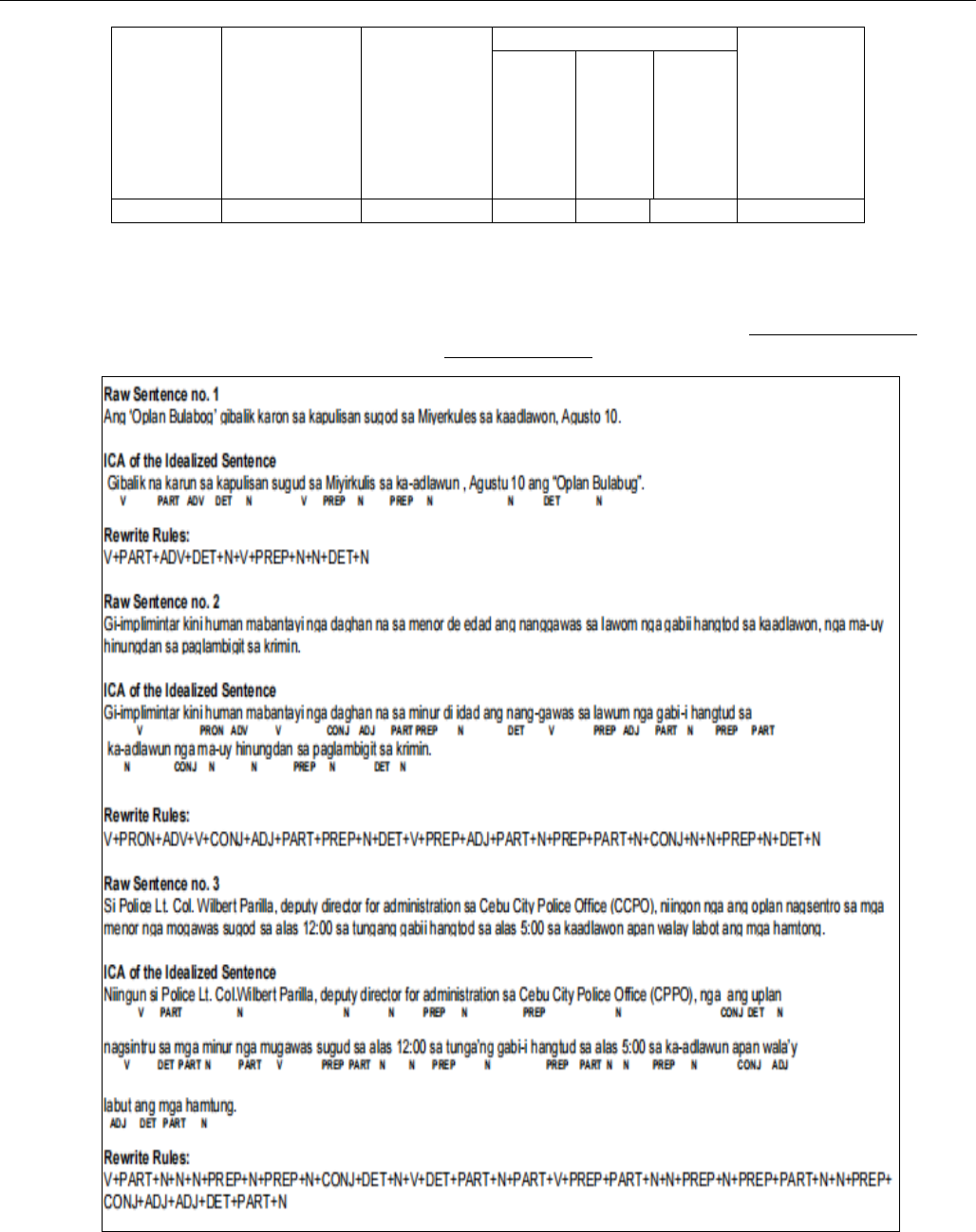
IJLS 3(2): 115-133
Page | 119
NOUNS
ENGLISH
TRANSLATION
FREE
MORPHEMES
(ROOTS)
BOUND MORPHEMES
FORM
(SIMPLE,
COMPOUND,
COMPLEX)
prefix
infix
Suffix
pinulungan
language
pulung
-in-
-an-
complex
4. Results and Discussion
This section presents the analysis and interpretation of the data gathered. The data follow the specific sequence as outlined below.
Table 1. Syntactic structures of the Cebuano-Visayan SuperBalita news article: 34 ka menor de edad
naluwas sa CCPO”
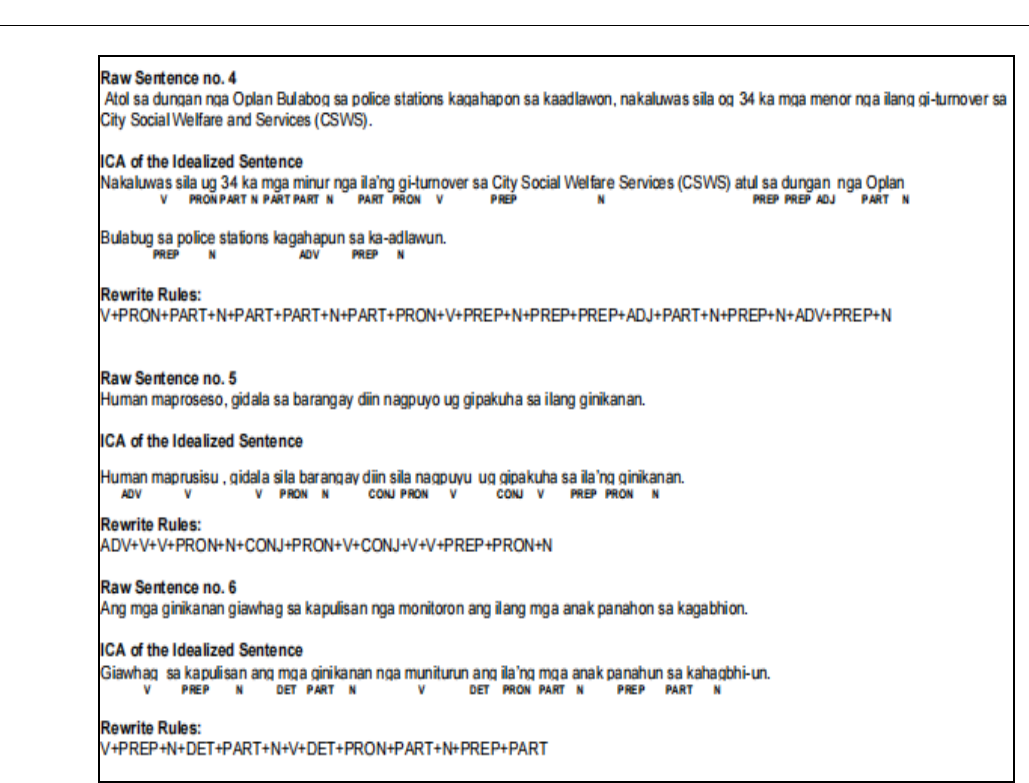
Cebuano-Visayan Superbalita Select News Articles:A Morphosyntactic Analysis
Page | 120
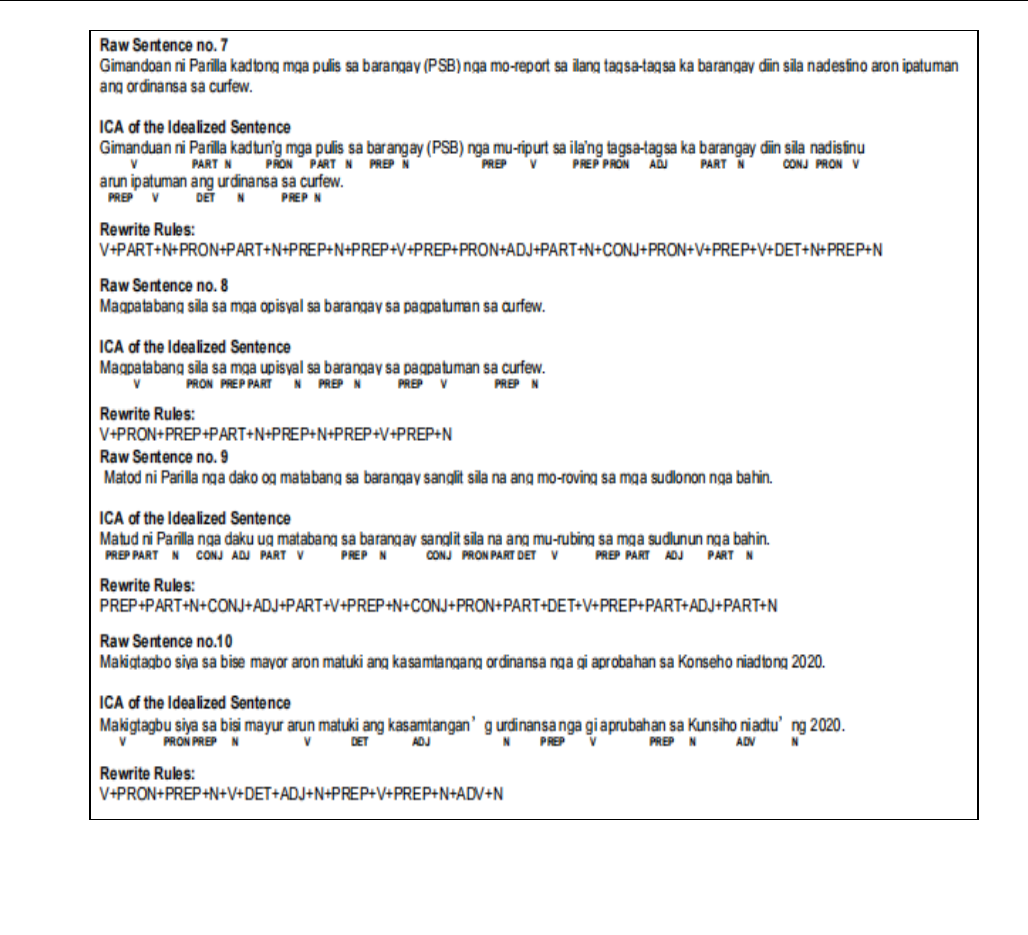
IJLS 3(2): 115-133
Page | 121
Table 1 shows the initial constituent analyses and rewriting rules of the first selected news story, "34 ka menor de edad naluwas sa
CCPO". Sentences 2,5,7,8 and 10 use intellectualized Cebuano-Visayan sentence structure. On the other hand, sentences 1,3,4,6
and 9 do not follow the predicate structure of the Cebuano-Visayan; thus, these are idealized by incorporating the initial-verb
construction. Sentences 1,6,8 and 10 are simple, 2,4,5,7, and 9 are complex, and 3 is compound.
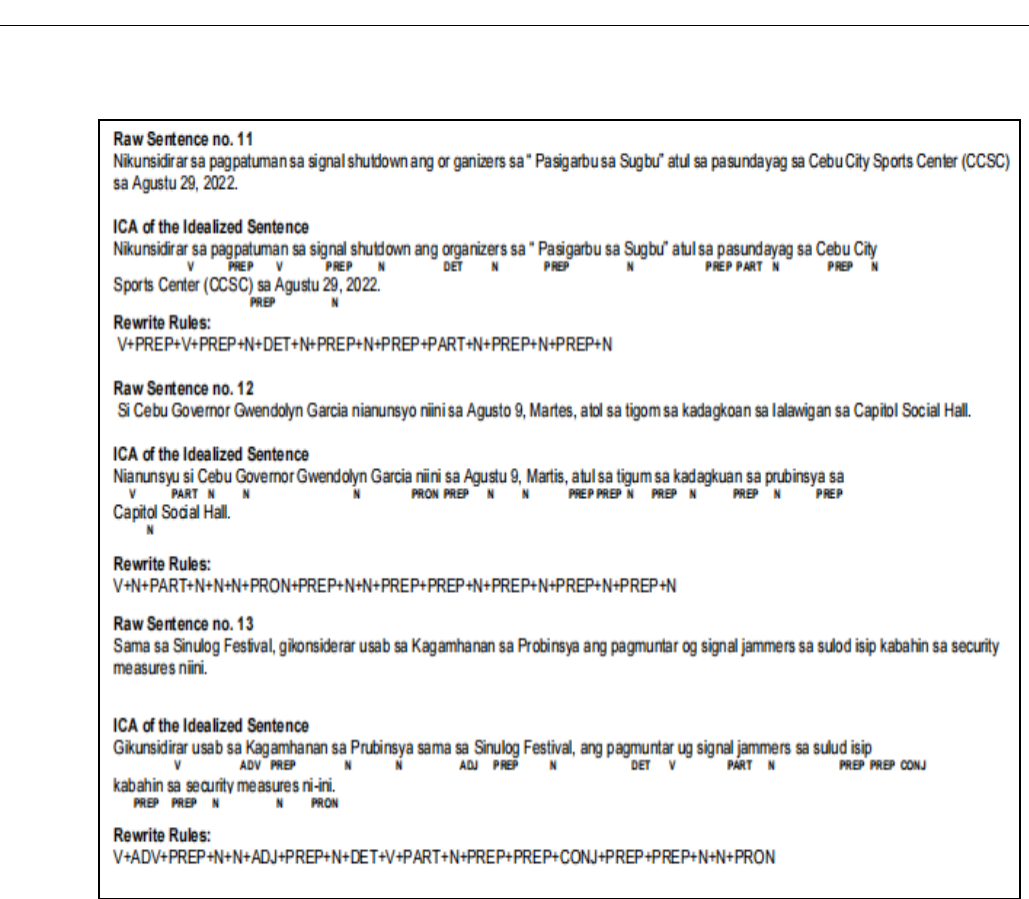
Cebuano-Visayan Superbalita Select News Articles:A Morphosyntactic Analysis
Page | 122
Table 2. Syntactic structures of the Cebuano-Visayan SuperBalita news article: Signal shutdown sa
Pasigarbo sa Sugbo.
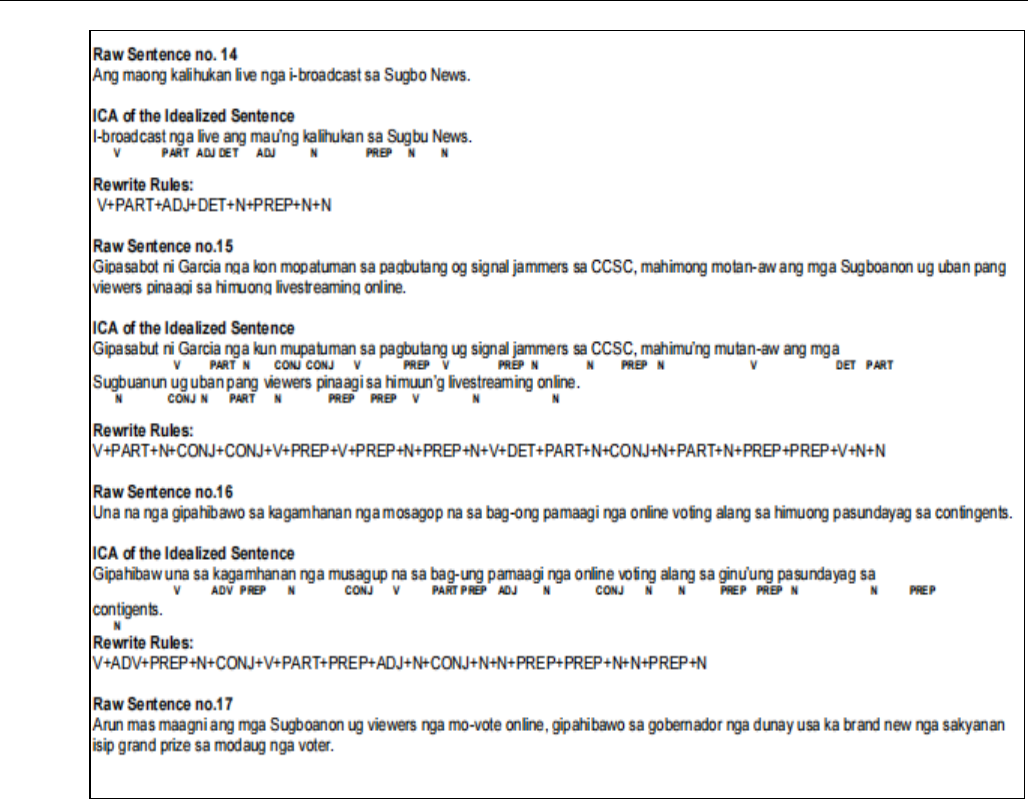
IJLS 3(2): 115-133
Page | 123
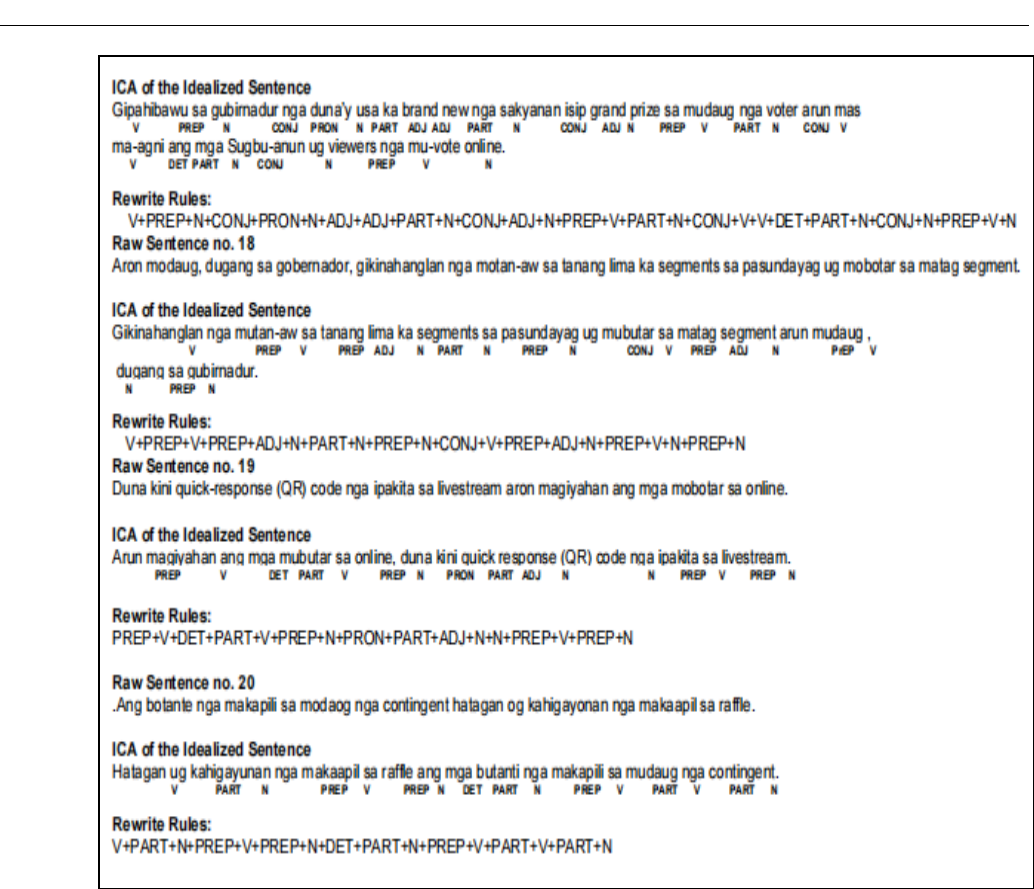
Cebuano-Visayan Superbalita Select News Articles:A Morphosyntactic Analysis
Page | 124
Table 2 reveals the immediate constituent analyses and the rewrite rules of the second news article entitled “Signal shutdown sa
Pasigarbo sa Sugbo”. Regarding its sentence form, the data show eight simple sentences (11,12,13, 14, 16, 20, and 21) and three
complex sentences which are (15,17 and 19). The majority of the sentences start with noun phrases and do not follow the predicate
construct of the Cebuano-Visayan language. The inaccurate sentence arrangements are the following: sentences
12,13,14,16,17,18,19 and 20. Only sentences 11 and 15 utilized the predicate-subject format.
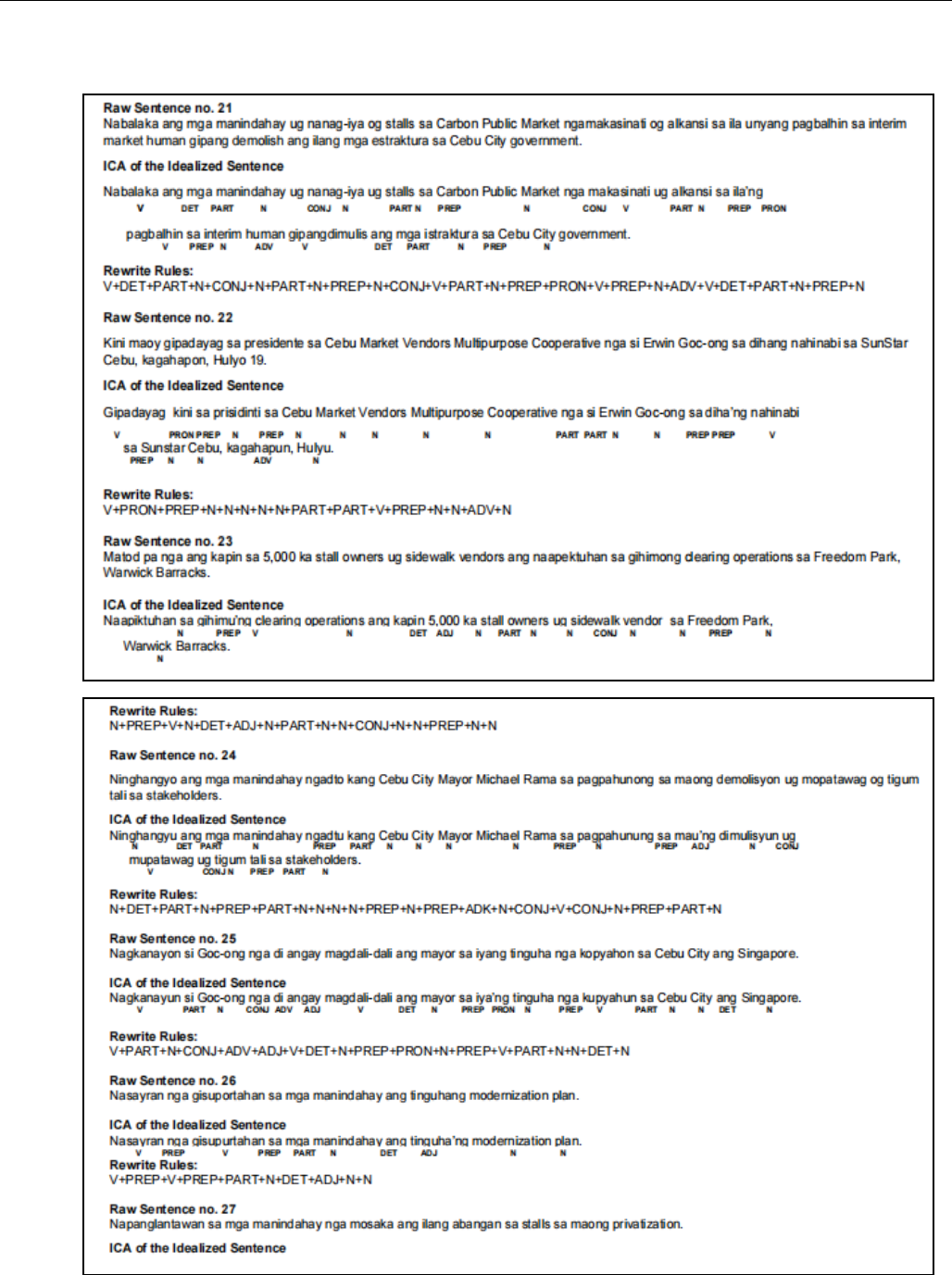
IJLS 3(2): 115-133
Page | 125
Table 3
Syntactic structures of the Cebuano-Visayan SuperBalita news article: “Manindahay sa Carbon nabalaka
sa grabi’ng alkansi”
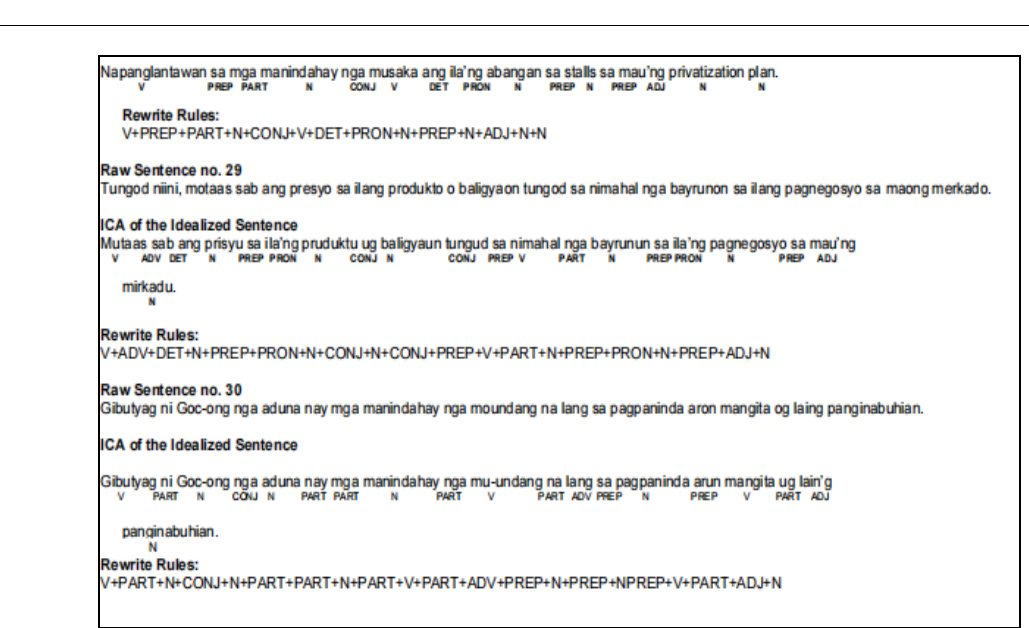
Cebuano-Visayan Superbalita Select News Articles:A Morphosyntactic Analysis
Page | 126
Table 3 reveals the immediate constituent analyses and the rewrite rules of the third news article entitled “ Manindahay sa Carbon
nabalaka sa grabi’ng alkansi”. The textuality shows four simple sentences (24, 26, 27, 28, and 30), three complex sentences (22, 2,3
and 29), and one compound sentence, which is sentence 25. Regarding the Cebuano-Visayan predicate-construct, sentences 22,
23 and 24 do not follow the mentioned sentence arrangement, while seven out of ten sentences utilize the verb-initial structure
of the article.
Immediate constituent analysis (IC Analysis) is a grammatical analysis approach in linguistics that splits sentences into successive
layers or constituents. Any word or phrase that appears in a larger phrase or sentence is referred to as a constituent. Immediate
constituent analysis is the process of studying units of a language, such as a word, phrase, clause, or sentence. In other words, IC
analysis is the breakdown of a phrase into its components or immediate parts.
In common with other Philippine languages, the predicate in Cebuano-Visayan exhibits a variety of sentence structures. Cebuano
Visayan is a language that is based on a construct system. In Cebuano Visayan, it is a grammatical convention for the subject to
initiate the sentence and the predicate to conclude it. Examples of predicates include noun predicates, adjective predicates, adverb
predicates, prepositional phrase predicates, and intransitive or transitive verb predicates. Cebuano is a language that follows a
verb-initial structure in two frameworks. In these frameworks, a sentence is primarily composed of a verb that is succeeded by a
series of noun phrases.
Morphemic Structures of Content Words. This stage involves the identification of both free and bound morphemes present in
the content words extracted from the Cebuano-Visayan select textuality. The categorization of content words is delineated in a
distinct table for each category, namely nouns, verbs, adjectives, and adverbs.
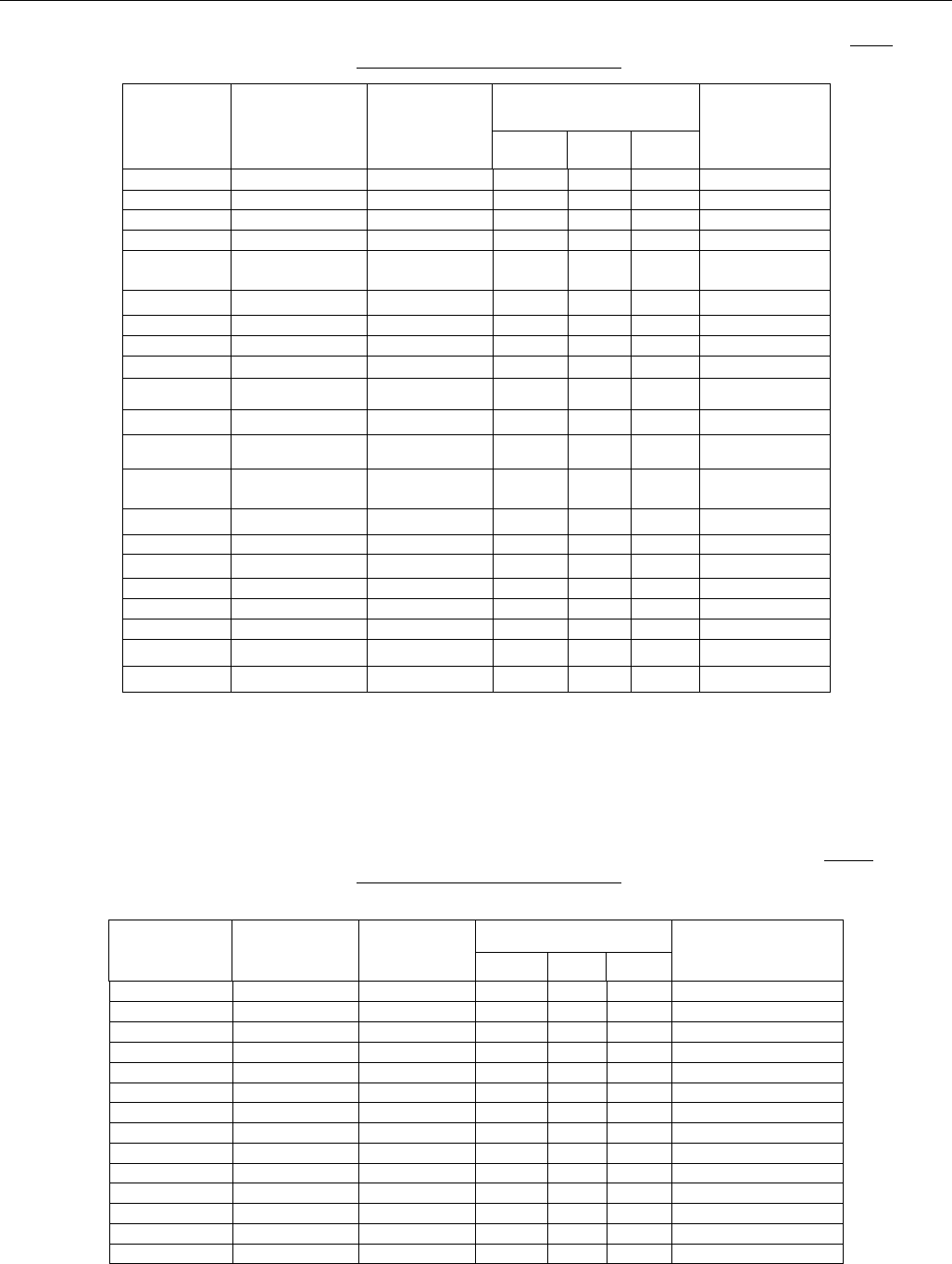
IJLS 3(2): 115-133
Page | 127
Table 4. Morphemic Structures of Nouns of the Cebuano-Visayan SuperBalita news article: 34 ka
menor de edad naluwas sa CCPO”
Table 4 reveals the morphemic structures of nouns in the first news article entitled “34 ka menor de edad naluwas sa CCPO”. The
textuality reveals twenty-one (21) nouns. Twelve out of twenty-one nouns are categorized as simple in form, five are complex, and
three are compound words which are the uplan bulabug, minur di idad, and tunga’ng gabi-i. The bound morphemes “ka”, “pag”,
“in”, “an”, and yal are commonly present in the text.
Table 5. Morphemic Structures of Nouns of the Cebuano-Visayan SuperBalita news article: “Signal
shutdown sa Pasigarbo sa Sugbo”
NOUNS
ENGLISH
TRANSLATION
FREE
MORPHEMES
(ROOTS)
BOUND MORPHEMES
FORM (SIMPLE,
COMPOUND,
COMPLEX)
PREFIX
INFIX
SUFFIX
kapulisan
police
pulis
ka
-
san
complex
Miyirkulis
Wednesday
Miyirkulis
-
-
-
simple
Agustu
August
Agustu
-
-
-
simple
ka-adlawun
dawn
adlaw
ka
-
un
complex
oplan
bulabug
oplan bulabug
uplan-bulabug
-
-
-
compound
gabi-i
night
gabi-i
-
-
-
simple
hinungdan
cause
hinungdan
-
-
-
simple
paglambigit
involvement
lambigit
pag
-
-
complex
krimin
crime
krimin
-
-
-
simple
minur di idad
minors
minur di idad
-
-
-
compound
hamtung
adult
hamtung
-
-
-
simple
barangay
barangay
barangay
-
-
-
simple
tunga’ng-
gabi-i
midnight
tunga nga gabi-
i
-
-
-
compound
ginikanan
parents
gikan
-
in
an
complex
anak
child
anak
-
-
-
simple
pulis
police
pulis
-
-
-
simple
urdinansa
ordinance
urdinansa
-
-
-
simple
upisyal
official
upis
-
-
yal
complex
bahin
part
bahin
-
-
-
simple
mayur
mayor
simple
kunsihu
council
kunsihu
-
-
-
simple
NOUNS
ENGLISH
TRANSLATION
FREE
MORPHEMES
(ROOTS)
BOUND MORPHEMES
FORM (SIMPLE,
COMPOUND,
COMPLEX)
PREFIX
INFIX
SUFFIX
pasigarbu
pride
garbu
pasi
-
-
complex
Martis
Tuesday
Martis
-
-
-
simple
kadagkuan
head
dagku
ka
-
an
complex
prubinsya
province
prubinsya
-
-
-
simple
kagamhanan
office
gahum
ka-
an
complex
kalihukan
event
lihuk
ka
-
an
complex
sugbu
cebu
sugbu
-
-
-
simple
sugbu-anun
cebuano
sugbu
-
-
anun
complex
pama-agi
method
agi
pama
-
-
complex
pasundayag
performance
pasundayag
-
-
-
simple
sakyanan
car
sakay
-
an
an
complex
kahigayunan
chance
higayun
ka
-
an
complex
butanti
voter
butar
-
-n
ti
complex
kasumaran
celebration
sumad
ka
-
an
complex

Cebuano-Visayan Superbalita Select News Articles:A Morphosyntactic Analysis
Page | 128
Table 5 reveals the morphemic structures of nouns in the second news article entitled “Signal shutdown sa Pasigarbo sa Sugbo”.
The data presents fourteen (14) nouns where four (4) words are categorized as simple, and ten words are complex. Five nouns in
complex form utilize the prefix “ka” like kadagku-an, kagamhanan, kalihukan, kahigayuan, and kasumaran while the other two use
the prefix “pama” and “pasi” from the base words pama-agi and pasigarbu. Six complex words use the suffix “an” while the
remaining two use the suffix “ti” from the word butanti and “anun” from the root Sugbu.
Table 6. Morphemic Structures of Nouns in the Cebuano-Visayan News Article: “Manindahay sa
Carbon nabalaka sa grabi’ng alkansi”
Table 6 reveals the morphemic structures of nouns in the second news article entitled “Manindahay sa Carbon nabalaka sa grabi’ng
alkansi”. The textuality shows seven (7) complex nouns and eight (8) simple nouns. The majority of the complex words utilize the
prefix “ pag” and “ma” and the suffix “an”, “un”, and “yun”.The morphology of the language is complex and is highly involved in
the grammaticalization of ideas and concepts.
Table 7. Morphemic Structures of Verbs in the Cebuano Visayan News Articles “ 34 ka menor de edad
naluwas sa CCPO”
1. VERBS
ENGLISH
TRANSLATI
ON
FREE
MORPHEMES
(ROOTS)
BOUND
MORPHEMES
FORM (SIMPLE,
COMPOUND,
COMPLEX)
PREF
IX
INFI
X
SUFFI
X
2. gibalik
have
returned
balik
gi
-
-
complex
3. sugud
starting
sugud
-
-
-
simple
4. gi-
implimintar
is
implemente
d
implimintara
gi
-
ar
complex
5. mabantayi
noticing
bantay
ma-
-
i
complex
6. nang-gawas
going out
gawas
nang
-
-
simple
7. ni-ingun
said
ingun
ni
-
-
complex
8. nagsintru
centering
sintru
nag
-
-
complex
9. mugawas
go out
gawas
mu
-
-
complex
10. nakaluwas
rescued
luwas
naka
-
-
complex
11. gidala
turned over
dala
gi
-
-
complex
12. nagpuyu
residing
puyu
nag
-
-
complex
13. gipakuha
get
kuha
gipa
-
-
complex
14. gi-awhag
encourage
awhag
gi
-
-
complex
NOUNS
ENGLISH
TRANSLA
TION
FREE
MORPHEMES
(ROOTS)
BOUND MORPHEMES
FORM
(SIMPLE,
COMPOUND,
COMPLEX)
PREFIX
INFIX
SUFFIX
1. manindahay
vendor
tinda`
ma
in
-
complex
2. mirkadu
market
mirkadu
-
-
-
simple
3.alkansi
loss
alkansi
-
-
-
simple
4.pagbalhin
transfer
balhin
pag
-
-
complex
5.istruktura
structure
istruktura
-
-
-
simple
6. insidinti
incident
insidinti
-
-
-
simple
7. dimulisyun
demolition
dimulis
-
-
yon
complex
8. tigum
meeting
tigum
-
-
-
simple
9. tinguha
aim
tinguha
-
-
-
simple
10.abangan
rent
abang
-
-
an
complex
11. prisyu
price
prisyu
-
-
-
simple
12. bayrunun
bill
bayad
-
un
un
complex
13. pruduktu
product
pruduktu
-
-
-
simple
14.baligya-un
for sale
baligya
-
-
un
complex
15.pagnisgusyu
business
nigusyu
pag
-
-
complex

IJLS 3(2): 115-133
Page | 129
15. muniturun
monitor
munitur
-
-
un
complex
16. gimandu-an
mandated
mandu
gi
-
an
complex
17. mu-ripurt
to report
ripurt
mu
-
-
complex
18. nadistinu
destined
distinu
na
-
-
complex
19. ipatuman
implemente
d
tuman
ipa
-
-
complex
20. magpataba
ng
ask help
tabang
magp
a
-
-
complex
21. pagpatuma
n
enforce
tuman
pagp
a
-
-
complex
22. makigtagbu
seek a
meeting
tagbu
maki
ng
-
-
complex
23. matuki
search
tuki
ma
-
-
complex
24. gi-
aprubahan
was
approved
aprubar
gi
-
han
complex
Table 7 reveals the morphemic structures of verbs in the first news article entitled “ 34 ka menor de edad naluwas sa CCPO”. The
data show twenty-three (23) verbs, and twenty-two (22) of those words are categorized as complex. Most of the prefixes used are
found to be the bound morphemes “gi”, “nag”, “mag”, “gipa”, and “mu”. Only one simple word was found, which is the
word”sugud”, which means start in English.
Table 8. Morphemic Structures of Verbs in the Cebuano Visayan News Articles “ Signal Shutdown sa
Pasigarbu sa Sugbu”
VERBS
ENGLISH
TRANSLATI
ON
FREE
MORPHEMES
(ROOTS)
BOUND
MORPHEMES
FORM
(SIMPLE,
COMPOUND,
COMPLEX)
PRE
FIX
INF
IX
SUFF
IX
nikunsidirar
considered
kunsidirar
ni
-
ar
complex
ni-anunsyu
announced
anunsyu
ni
-
-
complex
pagmuntar
mounting
muntar
pag
-
-
complex
gipasabut
mean
sabut
gi
-
-
complex
mutan-aw
check
tan-aw
mu
-
-
complex
gipahibaw
inform
hibaw
gipa
-
-
complex
musagup
to save
sagup
mu
-
-
complex
muda-ug
to win
da-ug
mu
-
-
complex
magiyahan
to be
guided
giya
ma
-
han
complex
gikinahanglan
needed
kinahanglan
gi
-
-
complex
hatagan
give
/provide
-hatag
-
-
an
complex
ipakita
show
kita
ipa
-
-
complex
makaapil
can join/
participate
apil
mak
a
-
-
complex
makapili
can choose
pili
mak
a
-
-
complex
nasayran
learned/disc
overed
sayud
na
-
an
complex
mu-apil
to join
apil
mu
-
-
complex
Table 8 reveals the morphemic structures of verbs in the second news article entitled “ Signal Shutdown Sa Pasigarbu Sa Sugbu”.
The data show sixteen verbs, and all of these are in complex forms.

Cebuano-Visayan Superbalita Select News Articles:A Morphosyntactic Analysis
Page | 130
Table 9. Morphemic Structures of Verbs in the Cebuano Visayan News Articles “ Manindahay sa Carbon
nabalaka sa grabi’ng alkansi”
VERBS
ENGLISH
TRANSLAT
ION
FREE
MORPHEME
S (ROOTS)
BOUND
MORPHEMES
FORM
(SIMPLE,
COMPOUN
D,
COMPLEX)
pre
fix
inf
ix
suffi
x
nabalaka
concerned/
worried
balaka
na
-
-
Complex
makasinati
experience
sinati
mak
a
-
-
Complex
gipangdimulis
demolished
dimulis
gipa
’ng
-
-
complex
gipadayag
expressed
dayag
gipa
-
-
complex
nahinabi
interview
tabi
nahi
-
-
complex
na-apiktuhan
affected
ipiktu
na
-
han
complex
gihimu
done
himu
gi
-
-
complex
nihangyu
asked
hangyu
ni
-
-
complex
papahunung
stopping
hunung
pag
pa
-
-
complex
mupatawag
call out
tawag
pag
pa
-
-
complex
nagkanayun
said
nayun
nag
ka
-
-
complex
magdali-dali
hurry
dali
ma
g
-
-
complex
kupyahun
copy
kupya
-
-
hun
complex
nasayran
discovered
sayud
na
-
an
Complex
gisupurtahan
supported
supurta
gi
-
han
complex
napaglantawan
can be
anticipated
lantaw
na-
pag
-
an
complex
musaka
increase
saka
mu
-
-
complex
mutaas
increase
taas
mu
-
-
complex
nimahal
increase in
price
mahal
ni
-
-
complex
Table 9 reveals the morphemic structures of verbs in the third select news article entitled “ Manindahay sa Carbon nabalaka sa
grabi’ng alkansi”. There are nineteen (19) verbs, and all of these words are complex in form. The majority of the prefixes used are
the following: gipa, pagpa,mu, ni, na, and maka.
Table 10. Morphemic Structures of Adjectives in the Cebuano Visayan News Article “ 34 ka menor de
edad naluwas sa CCPO”
ADJECTIVES
ENGLISH
TRANSLATI
ON
FREE
MORPHEMES
(ROOTS)
BOUND
MORPHEMES
FORM
(SIMPLE,
COMPOUND,
COMPLEX)
PREF
IX
INF
IX
SUFFI
X
daghan
more
daghan
-
-
-
Simple
lawum
deep
lawum
-
-
-
simple
daku
big
daku
-
-
-
simple
sudlunun
remote
sulud
-
un
un
complex
kasamtangan
current
samtang
ka
-
an
complex

IJLS 3(2): 115-133
Page | 131
Table 10 reveals the morphemic structures of adjectives in the first select news article, “ 34 ka menor de edad naluwas sa CCPO”.
There are three (3) simple words and two (2) complex words. The bound morphemes display the use of affixes ka, un, and an.
Table 11. Morphemic Structures of Adjectives in the Cebuano Visayan News Articles “Signal Shutdown
sa Pasigarbu sa Sugbu”
ADJECTIVES
ENGLISH
TRANSLAT
ION
FREE
MORPHEME
S (ROOTS)
BOUND
MORPHEMES
FORM
(SIMPLE,
COMPOUN
D,
COMPLEX)
PRE
FIX
IN
FIX
SUFF
IX
bag-u
new
bag-u
-
-
-
simple
Table 11 reveals one adjective which is simple in form.
Table 12. Morphemic Structures of Adjectives in the Cebuano Visayan News Articles “Manindahay sa
Carbon nabalaka sa grabi’ng alkansi”
ADJECTIVES
ENGLISH
TRANSLATIO
N
FREE
MORPHEME
S (ROOTS)
BOUND
MORPHEMES
FORM
(SIMPLE,
COMPOUND,
COMPLEX)
PREFIX
INF
IX
SUFFI
X
di angay
Not
appropriate
Angay
-
-
-
compound
Table 12 reveals one adjective from the third select news article, “Manindahay sa Carbon nabalaka sa grabi’ng alkansi”. The word
“di angay” is compound in form since it is composed of two words.
Table 13. Morphemic Structures of Adverbs in the Cebuano Visayan News Article “ 34 ka menor de edad
naluwas sa CCPO”
ADVERBS
ENGLISH
TRANSLATION
FREE
MORPHEMES
(ROOTS)
BOUND MORPHEMES
FORM (SIMPLE,
COMPOUND,
COMPLEX)
PREFIX
INFI
X
SUFFIX
1.karun
now
karun
-
-
-
simple
2. human
after
human
-
-
-
simple
Table 13 reveals two adverbs in the first select news article, “ 34 ka menor de edad naluwas sa CCPO”. The words karun and human
are both simple in form.
Table 14. Morphemic Structures of Adverbs in the Cebuano Visayan News Articles “Signal Shutdown sa
Pasigarbu sa Sugbu”
ADVERBS
ENGLISH
TRANSLATION
FREE
MORPHEMES
(ROOTS)
BOUND MORPHEMES
FORM (SIMPLE,
COMPOUND,
COMPLEX)
PREFIX
INFIX
SUFFIX
1. sama
like
sama
-
-
-
simple
Table 14 reveals one adverb from the second select news article, “Signal Shutdown sa Pasigarbu sa Sugbu” . The word “sama” is
simple in form.

Cebuano-Visayan Superbalita Select News Articles:A Morphosyntactic Analysis
Page | 132
Table 15. Morphemic Structures of Adverbs in the Cebuano Visayan News Articles “Manindahay sa Carbon
nabalaka sa grabi’ng alkansi”
ADVERBS
ENGLISH
TRANSLATION
FREE
MORPHEMES
(ROOTS)
BOUND MORPHEMES
FORM
(SIMPLE,
COMPOUND,
COMPLEX)
PREFIX
INFI
X
SUFFIX
1. kagahapun
yesterday
hapun
kaga
-
-
complex
2. human
after
human
-
-
-
simple
Table 15 reveals two adverbs in the third select news article, “Manindahay sa Carbon nabalaka sa grabi’ng alkansi” The word
“kagahapun” is complex in form with the prefix “kaga”, while the word “human” is simple.
Borello's discourse on English Cebuano Grammar provides substantiation for the subsequent examination of content words. The
individual has provided a catalog of affixes that are capable of being appended to the root word to generate adjectives in the
Cebuano language. The affixes can manifest in various forms, including prefix, suffix, circumfix, or infix. Examples of such forms are
as follows: The morpheme ma- can be affixed to a root word to intensify its meaning, as in the case of matahum, which means
beautiful.
The circumfix -ma and -un are utilized to derive an adjective that denotes possessing the quality of performing or undergoing an
action, as exemplified by the word malipayun (happy). The affixes "un," "hun," "an," and "han" are utilized to create adjectives that
connote both moral and physical attributes, as exemplified by the term "tabian", which denotes talkativeness. The prefix "ha-" is
utilized at the root level in order to create an adjective that pertains to distance or degree, as exemplified by the term "hata-as."The
prefix "hi-" is utilized to indicate frequency, as exemplified in the word "hingatugun".In academic writing, it is common to add the
infix "-g-" after the vowel of the initial syllable of an adjective that pertains to measurements in order to indicate plurality. This is
exemplified in the word "lagyu" (far), which becomes pluralized when referring to multiple objects. The prefix "maka-" is utilized
in conjunction with the initial syllable of the root word, which is then duplicated, as seen in the example of "makaluya."The addition
of the infix -in- between the initial two syllables and -on- to the final syllable of the prefix ma- results in the formation of an
adjective that denotes a particular quality, as exemplified by the term matinahuron. The infix -pa- is inserted between the
morphemes “ma” and the initial syllable of the root, while an additional morpheme is appended to the final syllable to generate
adjectives of quality, as exemplified by the term palabilabihon. Moreover, the prefix paki- is utilized to construct adjectives that
connote an intense fondness for a particular entity.
With the data presented above, it is determined that the syntactic and morphemic linearity of words are revealed in the select
textuality of Cebuano-Visayan SuperBalita news article.
5. Conclusion
The present study has investigated the morphosyntactic structures in three specific news articles from the Cebuano-Visayan
SuperBalita publication. The analysis provided valuable insights into the manifestation of morphosyntactic linearity in indigenous
languages. Findings revealed the presence of various simple, complex, and compound sentences and the morphemic structures
of content words within the texts. These findings highlight the importance of further research on morphology and syntax to
promote a deeper understanding of indigenous languages and their intricate language structures. It is essential to continue
exploring the complexities of language to foster a greater appreciation for the diversity of languages and cultures. In addition, the
study's findings can be used to develop pedagogical materials for teaching Cebuano-Visayan grammar. These materials can help
learners understand the language's morphosyntactic structures and how they are used to construct sentences. Thus, it is
recommended that teachers engaged in Cebuano-Visayan courses must display expertise in teaching the accurate morphoyntactic
features of the language.
5.1 Further Recommendations for Future Research
Based on the findings, the following topics are hereby recommended for future linguistic researchers:
1. Segmental Analysis of Cebuano-Visayan poems
2. Suprasegmental Features of Philippine English Variety as Spoken in Northern
Cebu
3. Morphological Analysis of Compound Words used in certain textuality
4. Morphological Analysis of “AWIT SA BOHOL”

IJLS 3(2): 115-133
Page | 133
5. Word-Formation Processes on Internet Slang Used by Filipino Millennials
6. Syntactic Analysis of Boholano poems
7. The Morphology of Nouns in the Visayan Daily Conversations
8. A Morphosyntactic Analysis of the Pronominal System of Cebuano-Visayan
Language
9. Morphological Borrowing: A Linguistics Ethnographic Study of Cebuano-Visayan
verb affix Adaptation
10. A Phonetic, Phonological and Morphosyntactic Analysis of the Cebuano-Visayan
Funding: This research received no external funding.
Conflicts of Interest: The authors declare no conflict of interest.
Publisher’s Note: All claims expressed in this article are solely those of the authors and do not necessarily represent those of
their affiliated organizations, or those of the publisher, the editors and the reviewers.
References
[1] Aronoff, M., & Fudeman, K. (2022). What is morphology? John Wiley & Sons.
[2] Alburo, E. K. (1990). NOTES ON THE LANGUAGE ISSUE, CEBUANO LITERATURE, AND NATIONAL IDENTITY. Philippine Quarterly of Culture and
Society, 18(4), 312-318.
[3] Bernad, M. A. (1972). A Dictionary of Cebuano Visayan.
[4] Borello, A. (2018). English Cebuano Visayan Grammar. United States of America: Villagio Publishing Ltd.
[5] Corder, S. (1973). Introducing applied linguistics
[6] Pesirla, A. (2012). Ang linggwistika sa Sugbu-anun’g Binisaya: The linguistics of Cebuano Visayan. Philippines.
[7] Thompson, R. M. (2003). Filipino English and Taglish: Language switching from multiple perspectives (Vol. 31). John Benjamins Publishing.
[8] Wolff, P. (2003). Direct causation in the linguistic coding and individuation of causal events. Cognition, 88(1), 1-48.
[9] Zorc, R. D. (1986). The genetic relationships of Philippine languages. In FOCAL II: Papers from the Fourth International Conference on
Austronesian Linguistics. Pacific Linguistics.
